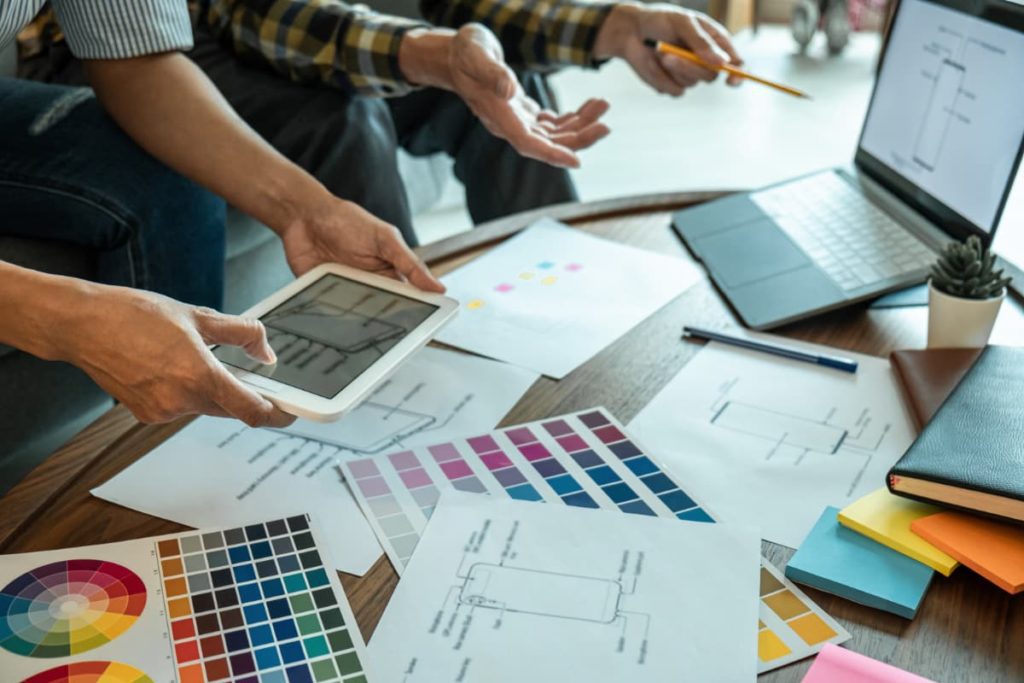Graphic designers construct visual conceptions by hand or with computer software, to speak ideas that inform and inspire customers. They combine art and technology to communicate ideas through images and the layout of web screens and printed pages. Graphic designers work with both text and images. Also developing the overall layout and making designs for advertisements, magazines, brochures and company reports. Graphic designers decide how images and text will go together on a page or screen, including how much space each will have.
The primary step in developing a new design is to find out the requests of the client, the message the design should portray, and its appeal to customers. Graphic designers consider cognitive, cultural, physical, and social factors in planning and executing designs for the target audience. Designers collect important information by meeting with clients and by performing their own research.
Graphic designers prepare sketches or layouts—by hand or with the aid of a computer—to illustrate their vision for the design. They choose sound, colors, photography, animation, style of type, and other visual elements for the design. Designers then present the completed design to their clients or art or creative director for approval.
Role of a graphic designer
The role of a graphic designer in today’s humanity has remained similar over the years, to communicate an idea, brand, or story in a visual way. Designers work in a multitude of fields, from fashion, architecture and graphic design to web and user experience. About the turn of the millennium, something changed, and ever since we have seen a constant shifting in the way that numerous designers come up to their job, a move away from this previous model. A graphic designer’s job has become more difficult in that it must stand out amongst the clutter that consumers are continuously being exposed to. Because the entrance to technology and information continues to increase, folks are starting to have shorter attention spans. Designs must be able to make a strong impression, quickly, since users are often switching between different devices and content at a high speed. On that note, a graphic designer’s changing role can come into play here.

The skills needed to be a graphic designer
In addition to postsecondary training in graphic design, creativity, communication, and problem-solving skills are crucial. Graphic design working is a dream career for many creative persons, but there are some crucial skills you will need to build up before you can successfully work in graphic design.
- Creative Thinking – It’s hard to come up with new ideas and innovative designs if you don’t know how to tap into your creative resources. You don’t necessarily need artistic skills to land a job in graphic design, but you’ll want a general understanding of basic artistic elements to help translate that to the computer.
- Communication skills – The ability to communicate is fundamental to everything that a designer does but it’s not just about visual communication. Understanding what a client wants from a design is the key to producing a successful product. In addition, designers have to be able to articulate their ideas and concepts to employers and clients with ease and fluency.
- Typography – It’s one of those rare skills that are essential for both the print and digital mediums unequivocally. Typography requires a firm understanding of the correct use of line height, font families, kerning and tracking.
- Software – Your technical skills play an important role in the execution of any idea. Accepting how to exploit the standard software will be key to landing your dream graphic design work. The most popular and well-known graphic design software comes from Adobe, with an entire creative suite including Photoshop, Illustrator, and InDesign.
- Photography – If you hope to be perceived as a good graphic designer, sooner or later you just want to take a picture. If you are fortunate enough to work for a company that supplies you with a camera, utilize it. It is an excellent idea to use a digital camera that provides enough pixel resolution.
- Web Design – For graphic designers, having a clear understanding of web development is more essential than ever in an age where online advertising and web presence are essential to every marketing campaign. Being fluent in web design and manifold coding languages will make you much more attractive to possible employers.
How do I find a graphic designer?
The first step is to define what you want, then identify the type and level of skill needed to make it happen. Start by defining a scope of work that focuses on three things: results, targets and time. As proposals are submitted, you’ll need to vet the most promising graphic designers to create a short list of people you want to interview. The best method to find a great designer is by word-of-mouth. Get a recommendation from someone you know and trust, or look to other businesses whose designs you admire and find out who created them. Make sure they’ve worked on something similar to your project. Also, when a designer shows you their portfolio, be sure to ask them what their exact role in each project was. Expect to pay a higher price for more experience and a larger project. Claim ownership of the final product. That way, if you ever want to make edits to the design, you have unrestricted access to the work.
